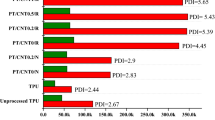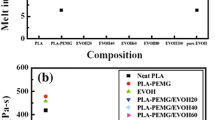Abstract
Poly (lactic acid) is an industrially mature, bio-sourced and biodegradable polymer. However, current applications of this eco-friendly material are limited as a result of its brittleness and its poorly melt properties. One of the keys to extend its processing window is to melt strengthen the native material. This paper considers the chain extension as a valuable solution for reaching such an objective. An additive based on epoxy-functionalized PLA was employed during reactive extrusion. The reaction times as a function of chain extender ratios were determined by monitoring the melt pressure during recirculating micro-extrusions. Once residence times were optimized, reactive extrusion experiments were performed on a twin screw extruder. Size exclusion chromatography provided information about the molecular weight distributions (MWD) of the modified PLAs and revealed the creation of a high molecular weight shoulder. The rheological experiments highlighted the enhancement of the melt properties brought about by the chain extension. Shear rheology revealed some enlarged and bimodal relaxation time spectra for the extended materials which are in accordance with the MWD analysis. Such a modification directly amplified the shear sensitivity of modified PLAs. Regarding the rheological temperature sensitivity, it was found to be decreased when the chain extender content is raised as shown from the Arrhenius viscosity fit. The reduction of the polar interactions from neat to highly chain-extended PLAs is here proposed to explain this surprising result. Chain extension was also found to impact on the elongational melt properties where strain hardening occurred for modified PLAs. Investigation of the chain extension architecture was made from the rheological data and revealed a long-chain branched topology for the modified PLAs.















Similar content being viewed by others
References
Al-Hadithi TSR, Barnes HA, Walters K (1992) The relationship between the linear (oscillatory) and nonlinear (steady-state) flow properties of a series of polymer and colloidal systems. Colloid Polym Sci 270(1):40–46
Baratian S, Hall ES, Lin JS, Xu R, Runt J (2001) Crystallization and solid-state structure of random polylactide copolymers: poly(l-lactide-co-d-lactide)s. Macromolecules 34(14):4857–4864
Barroso VC, Maia JM (2005) Influence of long-chain branching on the rheological behavior of polyethylene in shear and extensional flow. Polym Eng Sci 45(7):984–997
Bikiaris DN, Karayannidis GP (1996) Chain extension of polyesters PET and PBT with two new diimidodiepoxides. II. J Polym Sci, A, Polym Chem 34(7):1337–1342
Campbell JD, Debling JA, Deyoung DJ, Giannakitsas I, Dean RSDD, Teymour F, Villalobos MA (2000) Process for producing polymers by free radical polymerization and condensation reaction, and apparatus and products related thereto. S. C. Johnson, Sturtevant
Christopher GR, César AG-F, Srivatsan S (2004) Extent of branching from linear viscoelasticity of long-chain-branched polymers. J Polym Sci, B, Polym Phys 42(9):1671–1684
Cogswell FN (1972) Converging flow of polymer melts in extrusion dies. Polym Eng Sci 12(1):64–73
Cox WP, Merz EH (1958) Correlation of dynamic and steady flow viscosities. J Polym Sci 28(118):619–622
Dorgan JR, Joshua SW (1999) Melt rheology of poly(lactic acid): entanglement and chain architecture effects. J Rheol 43(5):1141–1155
Dorgan JR, Lehermeier H, Mang M (2000) Thermal and rheological properties of commercial-grade poly(lactic acid)s. J Polym Environ 8(1):1–9
Drumright RE, Gruber PR, Henton DE (2000) Polylactic acid technology. Adv Mater 12(23):1841–1846
Fleury G, Schlatter G, Muller R (2004) Non linear rheology for long-chain branching characterization, comparison of two methodologies: fourier transform rheology and relaxation. Rheol Acta 44(2):174–187
Graessley W (1975) The entanglement concept in polymer rheology. Adv Polym Sci 18:1–179
Gruber PR, Hartmann MH, Kolstad JJ, Witzke DR, Brosch AL (1996) Method of crosslinking PLA. PCT 94/08 508
Han CD, Jhon MS (1986) Correlations of the first normal stress difference with shear stress and of the storage modulus with loss modulus for homopolymers. J Appl Polym Sci 32(3):3809–3840
Haralabakopoulos AA, Tsiourvas D, Paleos CM (1999) Chain extension of poly(ethylene terephthalate) by reactive blending using diepoxides. J Appl Polym Sci 71(13):2121–2127
Henry EW, Chiu TH, Nyilas E, Brushart TM, Dikkes P, Sidman RL (1985) Nerve regeneration through biodegradable polyester tubes. Exp Neurol 90(3):652–676
Honerkamp J, Weese J (1993) A nonlinear regularization method for the calculation of relaxation spectra. Rheol Acta 32(1):65–73
Hsieh TT, Tiu C, Simon GP (2001) Melt rheology of aliphatic hyperbranched polyesters with various molecular weights. Polymer 42(5):1931–1939
Incarnato L, Scarfato P, Di Maio L, Acierno D (2000) Structure and rheology of recycled PET modified by reactive extrusion. Polymer 41(18):6825–6831
Japon S, Boogh L, Leterrier Y, Månson JAE (2000) Reactive processing of poly(ethylene terephthalate) modified with multifunctional epoxy-based additives. Polymer 41(15):5809–5818
Kim S, Dealy JM (2002a) Gross melt fracture of polyethylene. I: a criterion based on tensile stress. Polym Eng Sci 42(3):482–494
Kim S, Dealy JM (2002b) Gross melt fracture of polyethylene. II: effects of molecular structure. Polym Eng Sci 42(3):495–503
Labrecque LV, Kumar RA, Davé V, Gross RA, McCarthy SP (1997) Citrate esters as plasticizers for poly(lactic acid). J Appl Polym Sci 66(8):1507–1513
Lamnawar K, Maazouz A (2006) Rheological study of multilayer functionalized polymers: characterization of interdiffusion and reaction at polymer/polymer interface. Rheol Acta 45(4):411–424
Lamnawar K, Baudoin A, Maazouz A (2010) Interfacial reaction at the polymer/polymer interface in multilayer systems probed by linear viscoelasticity coupled to FTIR and NMR measurements. Eur Polym J 46(7):1604–1622
Lehermeier HJ, Dorgan JR (2001) Melt rheology of poly(lactic acid): consequences of blending chain architectures. Polym Eng Sci 41(12):2172–2184
Lipinsky ES, Sinclair RG (1986) Is lactic acid a commodity chemical? Chem Eng Prog 82:26–32
Liu C, Li C, Chen P, He J, Fan Q (2004) Influence of long-chain branching on linear viscoelastic flow properties and dielectric relaxation of polycarbonates. Polymer 45(8):2803–2812
Ljungberg N, Wesslén B (2002) The effects of plasticizers on the dynamic mechanical and thermal properties of poly(lactic acid). J Appl Polym Sci 86(5):1227–1234
Ljungberg N, Wesslén B (2003) Tributyl citrate oligomers as plasticizers for poly (lactic acid): thermo-mechanical film properties and aging. Polymer 44(25):7679–7688
Ljungberg N, Wesslen B (2005) Preparation and properties of plasticized poly(lactic acid) films. Biomacromolecules 6(3):1789–1796
Lopez Arraiza A, Sarasua JR, Verdu J, Colin X (2007) Rheological behavior and modeling of thermal degradation of poly(e-caprolactone) and poly(L-Lactide). Polym Process XXII 5:389–394
Lunt J (1998) Large-scale production, properties and commercial applications of polylactic acid polymers. Polym Degrad Stab 59(1–3):145–152
Martin O, Avérous L (2001) Poly(lactic acid): plasticization and properties of biodegradable multiphase systems. Polymer 42(14):6209–6219
Mc Kee MG, Unal S, Wilkes GL, Long TE (2005) Branched polyesters: recent advances in synthesis and performance. Prog Polym Sci 30(5):507–539
Mead D (1994) Numerical interconversion of linear viscoelastic material functions. J Rheol 38(6):1797
Mihai M, Huneault MA, Favis BD (2010) Rheology and extrusion foaming of chain-branched poly(lactic acid). Polym Eng Sci 50(3):629–642
Müller M, Seidel U, Stadler R (1995) Influence of hydrogen bonding on the viscoelastic properties of thermoreversible networks: analysis of the local complex dynamics. Polymer 36(16):3143–3150
Munari A, Pezzin G, Pilati F, Manaresi P (1989) Rheological characterization of highly branched poly(ethyleneterephthalate). Rheol Acta 28(1):25–29
Muñoz-Escalona A, Lafuente P, Vega JF, Santamaría A (1999) Rheology of metallocene-catalyzed monomodal and bimodal polyethylenes. Polym Eng Sci 39(11):2292–2303
Nam GJ, Yoo JH, Lee JW (2005) Effect of long-chain branches of polypropylene on rheological properties and foam-extrusion performances. J Appl Polym Sci 96(5):1793–1800
Nguyen QT, Japon S, Luciani A, Leterrier Y, Månson JAE (2001) Molecular characterization and rheological properties of modified poly(ethylene terephthalate) obtained by reactive extrusion. Polym Eng Sci 41(8):1299–1309
Palade LL, Lehermeier HJ, Dorgan JR (2001) Melt rheology of high L-content poly(lactic acid). Macromolecules 34:1384–1390
Park HE, Dealy J, Münstedt H (2006) Influence of long-chain branching on time-pressure and time-temperature shift factors for polystyrene and polyethylene. Rheol Acta 46:153–159
Pilla S, Kim SG, Auer GK, Gong S, Park CB (2009) Microcellular extrusion-foaming of polylactide with chain-extender. Polym Eng Sci 49(8):1653–1660
Randall JR, Cink K, Smith J (2006) Branched polylactic acid polymers and methodof preparing the same
Savvas GH (2000) Long chain branching and polydispersity effects on the rheological properties of polyethylenes. Polym Eng Sci 40(11):2279–2287
Schulze JS, Lodge TP, Macosko CW, Hepperle J, Münstedt H, Bastian H, Ferri D, Groves DJ, Kim YH, Lyon M, Schweizer T, Virkler T, Wassner E, Zoetelief W (2001) A comparison of extensional viscosity measurements from various RME rheometers. Rheol Acta 40(5):457–466
Seyed HT, Pierre JC, Abdellah A (2010) Rheological properties of blends of linear and long-chain branched polypropylenes. Polym Eng Sci 50(1):191–199
Stadler F, Kaschta J, Münstedt H, Becker F, Buback M (2009) Influence of molar mass distribution and long-chain branching on strain hardening of low density polyethylene. Rheol Acta 48(5):479–490
Tanaka Y, Bauer RS (1988) Epoxy resins—chemistry and technology. CRC, New York
Trinkle S, Walter P, Friedrich C (2002) Van Gurp-Palmen Plot II—classification of long-chain branched polymers by their topology. Rheol Acta 41(1):103–113
Tuominen J, Kylmä J, Seppälä J (2002) Chain extending of lactic acid oligomers. 2. Increase of molecular weight with 1,6-hexamethylene diisocyanate and 2,2′-bis(2-oxazoline). Polymer 43(1):3–10
Vert M, Schwarch G, Coudane J (1995) Present and Future of PLA Polymers. J Macromol Sci, Part A 32(4):787–796
Villalobos MA, Awojulu A, Greeley T, Turco G, Deeter G (2006) Oligomeric chain extenders for economic reprocessing and recycling of condensation plastics. Energy 31:3227–3234
Wehrenberg RH (1981) Lactic acid polymers: strong, degradable thermoplastics. Mater Eng 94(3):63–66
Wood-Adams P, Costeux Sp (2001) Thermorheological behavior of polyethylene: effects of microstructure and long-chain branching. Macromolecules 34(18):6281–6290
Wool RP (2005) Properties of triglyceride-based thermosets. Bio-based polymers and composites. Academic, Burlington, pp 202–255
Yingwei D, Salvatore I, Ernesto Di M, Luigi N (2005) Reactively modified poly(lactic acid): properties and foam processing. Macromol Mater Eng 290(11):1083–1090
Yolles S (1978) Time-release depo for anticancer drugs: release of drug covalently bonded to polymers. J Parenter Drug Assoc 32(4):188
Yolles S, Leaffe T, Ward L, Boettner F (1976) Controlled release of biologically active drugs. B Parenteral Drug Assoc 30(6):306–312
Zhou ZF, Huang GQ, Xu WB, Ren FM (2007) Chain extension and branching of poly(L-lactic acid) produced by reaction with a DGEBA-based epoxy resin. Express Polym Lett 1(11):734–739
Acknowledgements
The authors would thank Pr. Jean-Charles MAJESTE from our laboratory (Universté Jean Monnet–St Etienne (France)) for the extensional experiments.
Author information
Authors and Affiliations
Corresponding author
Rights and permissions
About this article
Cite this article
Corre, YM., Duchet, J., Reignier, J. et al. Melt strengthening of poly (lactic acid) through reactive extrusion with epoxy-functionalized chains. Rheol Acta 50, 613–629 (2011). https://doi.org/10.1007/s00397-011-0538-1
Received:
Revised:
Accepted:
Published:
Issue Date:
DOI: https://doi.org/10.1007/s00397-011-0538-1




